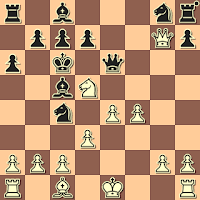
TCNB - Jerry_89
3 0 blitz, lichess.org, 2020
1.e4 e5 2.Nf3 Nc6 3.Bc4 Bc5 4.Bxf7+
4...Kxf7 5.Nxe5+ Nxe5 6.Qh5+ g6 7.Qxe5 Bxf2+
I have seen this move a lot, lately. Black wants to get the Queens off of the board, and is willing to return the sacrificed material - plus a pawn interest - to do so. White must change his expectations from an early attack on the King to winning a slow, methodical pawn-up Queenless middlegame.
8.Kxf2 Qh4+ 9.g3 Qf6+ 10.Qxf6+ Nxf6 11.Nc3 d6
White will get enough play if Black captures the pawn, i.e. 11...Nxe4 12.Kg1+ Kg7 13.d3 Nf6 14.Nc3 d6 15.Bg5 Rf8 16.Bxf6+ Rxf6 17.Rxf6 Kxf6 18.Nd5+
12.Kg2
Another recent game continued: 12.Rf1 Kg7 13.Kg2 b6 14.d3 Bb7 15.b3 c6 16.Bb2 Rhf8 17.Rf2 Kg8 18.Raf1 Nd7 19.Rxf8+ Rxf8 20.Rxf8+ Kxf8 21.h4 h5 22.Kf3 Kf7 23.Ne2 d5 24.exd5 cxd5 25.Kf4 Nf6 26.c4 dxc4 27.dxc4 Bc8 28.Bxf6 Kxf6 29.Nd4 Bd7 30.b4 Be6 31.Nxe6 Kxe6 32.Kg5 Kf7 33.c5 bxc5 34.bxc5 a5 35.c6 Ke6 36.Kxg6 Kd6 37.c7 Kc6 38.c8=Q+ Black resigned OnceaPawnaGambit64 - Gusejnov, 3 2 blitz, lichess.org, 2020
12...c6 13.d3 Bg4 14.Rf1 Kg7 15.Bf4 d5
Often in the Jerome Gambit the move ...d5 helps Black, but in this case it is overridden by tactical issues.
16.Be5 Rhf8 17.Rf2 Rae8 18.Bd4 dxe4 19.Nxe4 Bf5 20.Nxf6 Rxf6 21.Bxf6+ Kxf6 22.g4 Kg5 23.gxf5 gxf5
16.Be5 Rhf8 17.Rf2 Rae8 18.Bd4 dxe4 19.Nxe4 Bf5 20.Nxf6 Rxf6 21.Bxf6+ Kxf6 22.g4 Kg5 23.gxf5 gxf5
24.Raf1 Re5 25.h4+ Kxh4 26.Rxf5 Rxf5 27.Rxf5 Black resigned
graphic by Jeff Bucchino, "The Wizard of Draws"
graphic by Jeff Bucchino, "The Wizard of Draws"


































